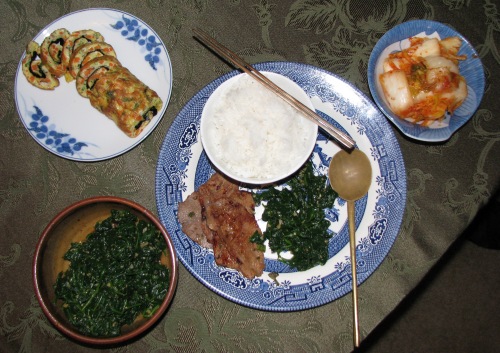
Traditional Korean meals consist of one or more main dishes and a 2 to as many as 20 side dishes known as banchan. The most well-known Korean side dish is kimchi. While spicy, pickled and fermented cabbage is the most popular form of kimchi, the Kimchi Field Museum in Seoul has documented 187 historic and current varieties of kimchi. Most kimchi uses some form of cabbage, radish or cucumber. Traditionally kimchi was fermented in large ceramic pots which were buried in the ground for moths. While it is possible to make your own kimchi, it is a long process (particularly if it fermented), so most folks just buy it at the store. From type to type and brand to brand there is a great deal of variation in the taste (and level of fermentation) of kimchi, if you try one that does not suit your taste buds, try another. Highly fermented kimchi might, for some, be an acquired taste but some Korean's eat it for nearly every meal.
The are a very large number of dishes that can be enjoyed as bachan (side dishes). We have listed two below, a Korean style omelet, and a spinach dish, but the pa jun we featured in a previous recipe of the month would be a suitable addition.
Bulgolgi
Bulgolgi, often referred to as "Korean BBQ", is spicy and sweet marinated meat that is grilled on a Korean-style grill. A smaller home version of a Korean grill can be purchased in either a Korean grocery (like Zion Market) store. It can be used on a gas stove or you can purchase an inexpensive butane burner (also widely available at Asian markets.) which makes the whole affair quite portable, perfect for a picnic! Given proper ventilation, you can set up the butane burner on your dining table, Bulgogi is delicious directly off the grill. Bulgogi is usually served with green leaf lettuce which is wrapped around the bulgolgi so that it can be eaten with the fingers. A typical condiment to spice the cooked meat is Korean red pepper paste (kochujang).
Gaeran Mari (Rolled Omelet)
Gaeran Mari is easy to make and looks fabulous on the table. In addition to being served as a side dish, it can also be eaten for breakfast, just like any other omelet. The toasted seaweed really sets gaeran mari apart from other omelets.
Ingredients:
- 3 eggs
- 1 scallion (green onion), finely sliced
- 1 small carrot, finely chopped
- 1 sheet Korean roasted seaweed (gim), Japanese nori works fine.
- salt and pepper to taste)
- olive oil for cooking
Preparation:
- Mix eggs with whisk or fork and add onions and carrots until well combined.
- In a lightly oiled sauté pan, pour egg mixture and heat slowly over low heat.
- Heat slowly for a few minutes until almost cooked through, then place seaweed sheet on top of omelette.
- Roll omelet into a tight roll by lifting side with spoon or baking spatula.
- Let omelet rest for a few minutes to cool.
- Slice into 1 inch pieces and serve on medium sized plate with cross-sections showing.
Sigumchi Namul (Seasoned Spinach)
Ingredients:
- 1 pound thoroughly washed spinach
- 3 tablespoons soy sauce
- 1 tablespoon sesame oil
- 1 tablespoon sesame seeds
- 2 cloves finely chopped garlic
- 1 teaspoon sugar
Preparation:
- Blanch the spinach in boiling water for 30 seconds.
- Remove spinach quickly and rinse in cold water.
- Gently squeeze the spinach to remove excess water.
- Mix soy sauce, sesame oil, seeds, garlic, and sugar together and then blend into the cooked spinach.
- Serve in a small side dish
Enjoy!
Recipes by T. Johnston-O'Neill
Photos: Shari Johnston-O'Neill








